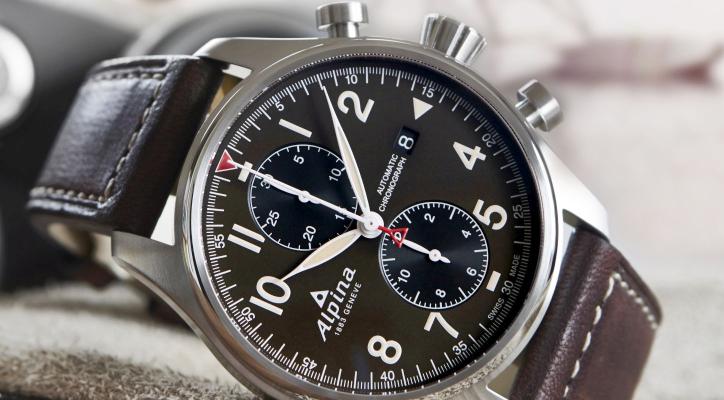
The 2016 Alpina Startimer Pilot chronograph (refs. AL-725B4S6, AL-725GR4S6 & AL-725N4S6) is available in three colors of its laconic, extremely sober dial and two colors of the genuine (*sigh*) leather strap. It is a bit expensive, many people may (and probably will) call it boring, and it is not a match to majors like IWC and Omega in terms of mojo and perceived value, yet the combination of a highly ergonomic design, reliable mechanism, and an acceptable price make it a nice everyday watch for a person who can afford one.
Overall Impression
Alpina didn’t wait for either SIHH 2017 or Baselworld to reveal this collection.
I mean, why bother? This perfectly -almost to a point of sterility, but later on that- designed wristwatch will probably be popular not only among the brand’s faithful fans but also among normal persons simply looking for a nice “pilot” to add to their collection. There is, from where I stand, no real need to invest a lot of cash into promoting this one: the price is on a higher side but adequate; the design is almost flawless; the mechanism, while not impeccable, has a good reputation among enthusiasts for its high reliability and ease of maintenance.
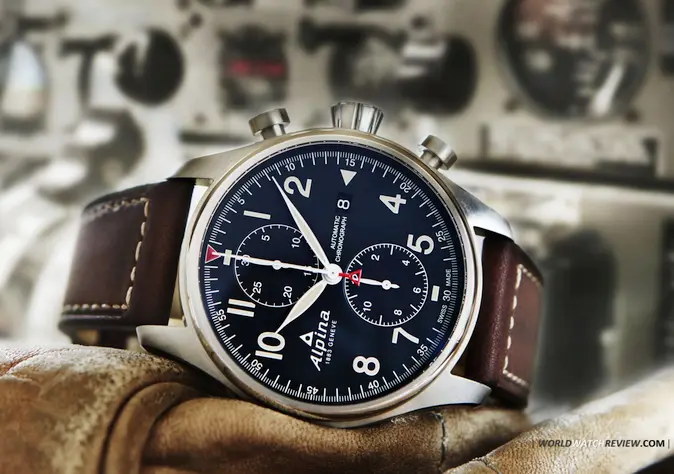
What’s most interesting here is that yours truly started to write this review enthusiastically impressed by the Startimer Pilot’s undisputable -yet sort of rugged- elegance and its carefully designed exterior.
However, the longer it took me to write yet another paragraph, the clearer was my understanding that the main (or, probably, the only) problem with this watch was that it is extremely, almost unbearably boring.
It looks like somebody thoroughly analyzed the most popular “aviators” within a designated price range, opened a spreadsheet, and then carefully calculated how it should look and feel. I am fairly sure that all of its parts were thoroughly reviewed by a board of experts and, probably, even tested with focus groups. You have a “classic Volkswagen”: an extremely well-designed, as practical as a mechanical watch could get and, again, boring.
Yes, that is my personal opinion here that may be biased to a degree, but that’s why there is the word “impression” in this section’s heading: right now while writing this review, I am scanning my feelings about the piece and trying to verbalize them. And I don’t like the words that form under my fingers.
After all, a watch in this price range is almost never bought for being practical: the niche of practical timepieces is dominated by Japanese quartz watches that cost ten times less. A timepiece that costs more than $2200 has to stimulate the emotional part of your brain and this one doesn’t do a good job in this department.
Yes, you will be happy about the build quality and the way the mechanism is good at keeping time, but I somehow doubt that, after a month or two when the honeymoon is over, you will take it off your wrist in the middle of a day only to admire its perfectly designed dial or the highly ergonomic winding crown. I mean, it is sort of stupid to go out of your office just to take a long look at your VW Golf parked nearby: there is nothing particularly interesting to look at, it’s just a car / a watch.
Again, I am not implying that this new member of the Startimer collection is bad in any way: it is a great product done by a team of skilled engineers, experienced industrial designers and other well-paid professionals that were involved in the process. It’s just that it’s boring. Or, at least, boring to me. Your mileage may vary.
Case & Strap
Approximately 44 millimeters in diameter, the case is not too large. In fact, for a “classic” aviator’s chronograph, it is even “normal” given how many recent “pilots” measured over 46 millimeters without crowns!
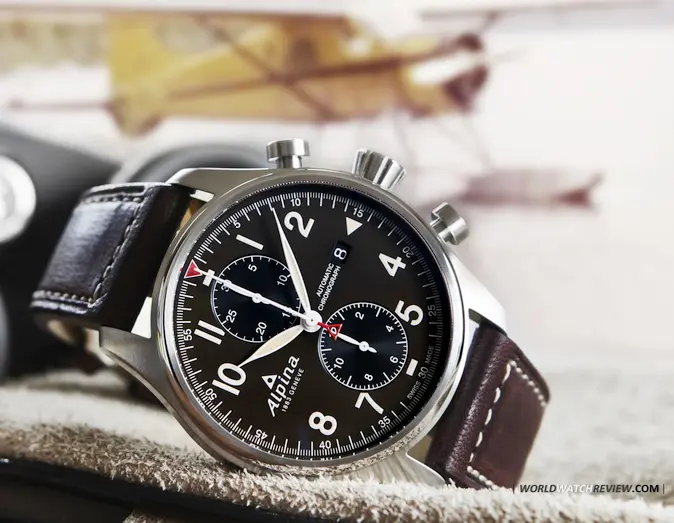
With its overall length of some 51 millimeters from tip to tip of its medium-sized horns, this Startimer Pilot almost fits within the average length of a modern timekeeper: if you happen to have a wrist of average (or above average) width, you are most probably golden.
If your wrist is small, but you still would love to have a deliberately oversized, attention-grabbing watch, you are golden, too. If neither condition listed above is satisfied, you would probably have to pass this model on, but that’s sort of obvious.
Sizing concerns notwithstanding, the body is nicely sculpted with all of its parts looking proportional to each other. Perhaps, that’s what I don’t like about this timekeeper: like old-school German cars and modern Japanese guitars, it looks calculated, lacking any sort of soul or, if you will, any sort of character.
The signature notched frustum-shaped crown makes it especially easy -although some may find that it feels a bit strange- to manipulate the movement: you don’t need to use your nails to pull off and unscrew the crown to set time or give the mechanism some initial energy to get it going.
The chronograph push-pieces are fairly unimaginative and, frankly, I am somewhat disappointed by how standard (if not generic) they are.
As far as finish goes, the combination of the machine-brushed case and the mirror-polished bezel is not terribly original, but it does the job of making the piece look visually lighter without losing even an ounce of its slightly heavy-weight, rugged charm.
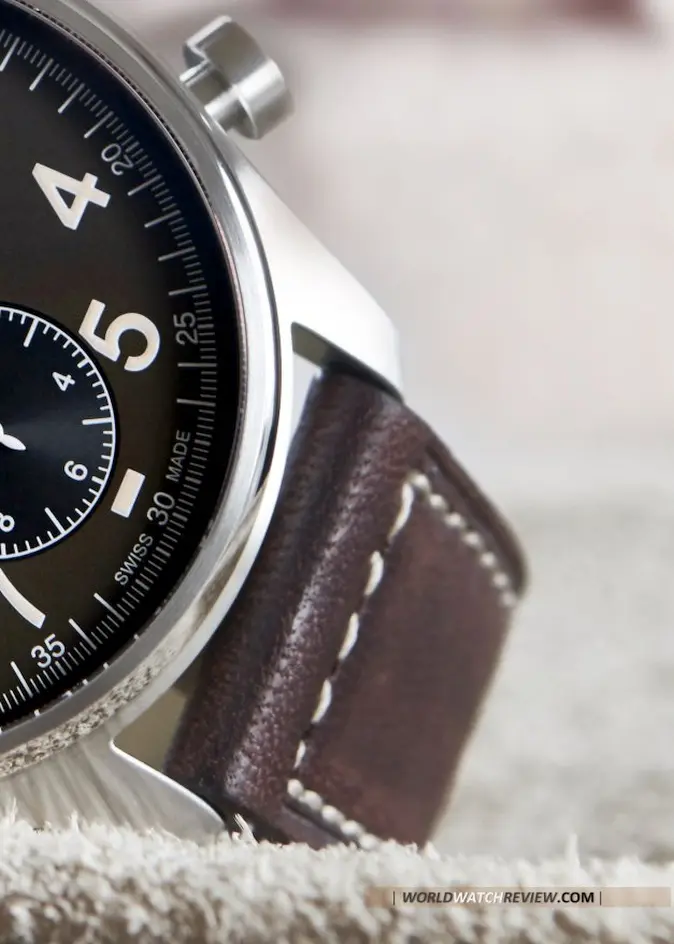
The ‘genuine’ leather (I don’t know why they needed to stipulate the fact that they saved a few dollars on using an inferior kind of leather here) strap has a nice used look to it although I would change it right away for a more expensive one crafted from a better, buy-it-for-life leather.
However, even as it is, it is more than enough for the first three or maybe four years until it finally disintegrates from all that sweat and exposure that a daily driver often gets.
Dial
As deliberately brutal as it is, the dial still plays nicely with subtle design clues especially when it comes to the dial. Although the version with matt black finish is more or less straightforward (also probably deliberately so) in its in-your-face approach, the pair of “colored” models with “Military Green” and “Navy Blue” color schemes look more interesting offering their sub-dials in slightly different colors that together provide the dials with more visual depth.
The egg-white Superluminova compound used for the hands, as well as the Arabic numerals and hour markers, too, make the white leaf-shaped hour and minute hands more three-dimensional and somehow more refined. By the way, if you’ll look closer, you will probably notice that the numerals are not painted, but are actually applied and, too, are white with only their tops painted by the same very light-beige luminescent compound.
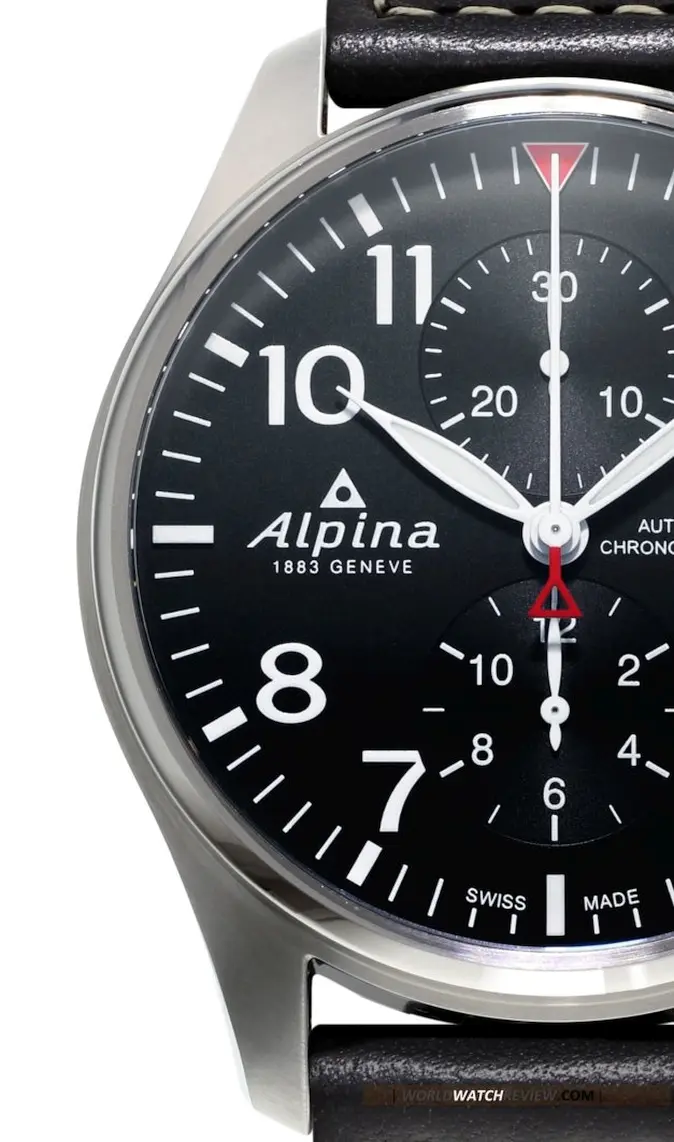
Frankly, I have an impression that the pair of red triangles (one serving as a counter-weight for the central chronograph second hand and the other staying at 12 o’clock replacing the respective digits) are a bit out of place here robbing the timekeeper of its rugged beauty, somehow making it look cheaper.
Of course, this is just a personal impression, but I have a feeling that to make the dial look more balanced, one of the triangles (probably, the one at 12 o’clock) should go: one splash of red is more than enough for this intentionally sober timekeeper with its purposely washed-off, vintage-look colors.
Well, maybe it’s not that big of a deal.
As usual for this mechanism (see below,) it features a relatively small date aperture with tiny white Arabic numerals printed over the black calendar wheel. The calendar is readable, but you would still need to put extra strain on your tired eyes to read it in poor lighting conditions. Otherwise, when it comes to legibility, the dial is almost perfect. I think, in this department, I would give it four and a half stars out of five.
Mechanism
Alpina has invested a considerable chunk of money into becoming a ‘true’ Manufacture. They (or rather the Japanese Citizen Holdings Co., Ltd. company that bought Alpina together with its Frederique Constant sister brand) have a good in-house Caliber AL-710 automatic movement that at some point started to supplant third-party calibers (mainly, those made by ETA and, to a lesser degree, Sellita) in an attempt to increase the perceived value of their timekeepers.
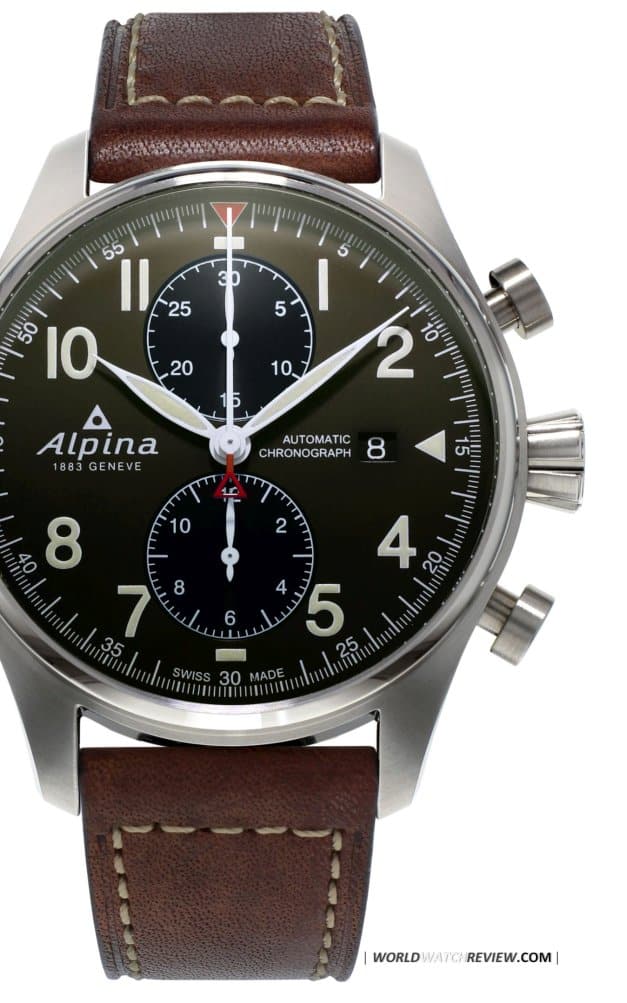
Nevertheless, some of their new collections still use mechanisms made by other brands. Some of them are simple three-handers with add-on modules, but this one is powered by the classic ETA Valjoux 7750 chronograph caliber.
Refinished to the brand’s specs and renamed as Caliber AL-725 (the company used it to power the gorgeous 2013 Extreme Diver 300 chronograph,) the mechanism will give you a good combination of reliability, precision, and ease of maintenance.
An interesting thing about this interpretation of the mechanism is that it lacks the usual small-second indicator: going for that classic bi-compax look, Alpina decided to ditch the sub-dial leaving only the 30-minute and 12-hour chronograph displays. For an insecure neurotic like me, the lack of the indicator is sort of disturbing: I want to know that my watch is running by seeing the small-second hand moving smoothly across its sub-dial. If you are okay with the design, that’s possibly a non-issue.
Regretfully, the movement is completely hidden from your eyes with a solid engraved case-back. On the other note, the ETA 7750 is not the most entertaining caliber to look at, so you probably would not miss much if it’s not the first mechanical watch in your collection.
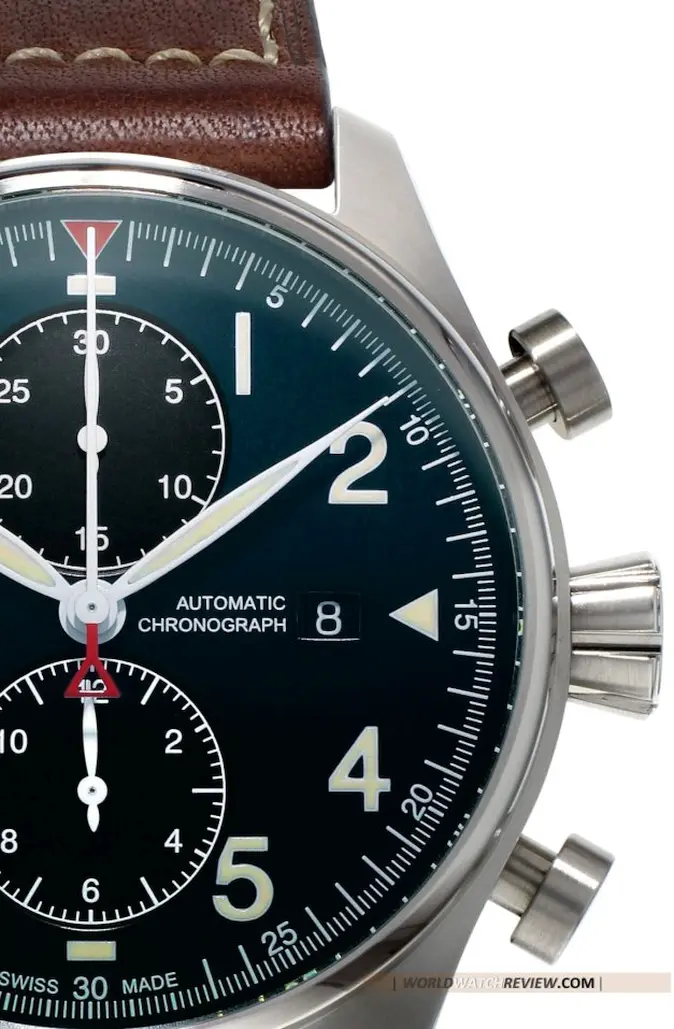
Pricing & Availability
Both versions are already available both in specialized brick-and-mortar shops and, of course, at Alpina’s online store. There, they are listed at CHF 2250 that roughly translates to a sort of intimidating $2260. Although the MSRP puts this timekeeper far, very far from being ‘affordable’, I must admit that the price is still competitive when it comes to similarly styled ETA 7750-equipped “pilots” from other European brands of similar pedigree.
WWR Verdict
Originality 4/5
Build Quality: 5/5
Usability: 4.5/5
Overall Legibility: 4.5/5
Nighttime Legibility: 4/5
Value for Money: 4/5
Overall Rating: 4/5
See also: Alpina Startimer Pilot Black Star Chronograph AL-860GB4FBS6
Photos: Alpina Watches
Alpina Startimer Pilot Chronograph specification
Price: CHF 2250 (MSRP)
Winding: Automatic
Movement: Caliber AL-725 (base ETA Valjoux 7750), Swiss Made
Number of jewels: 25
Movement frequency: 28,800
Power reserve: 46 hours
Movement decoration: Branded oscillating weight
Functions: Hours, minutes, chronograph, date
Case and Crown: Stainless steel, brushed
Bezel: Stainless steel, polished
Shape: Round
Size: 44.00 mm
Dial: Matt black / Military green / Navy blue
Numerals: Arabic, luminous, applied
Hour markers: Luminous
Hands: White, luminous
Water resistance: 100 meters
Strap: Genuine leather strap in black or brown with white contrast stitching, 22/18 mm
Crystal: Sapphire, antireflective
Back: Solid, engraved
